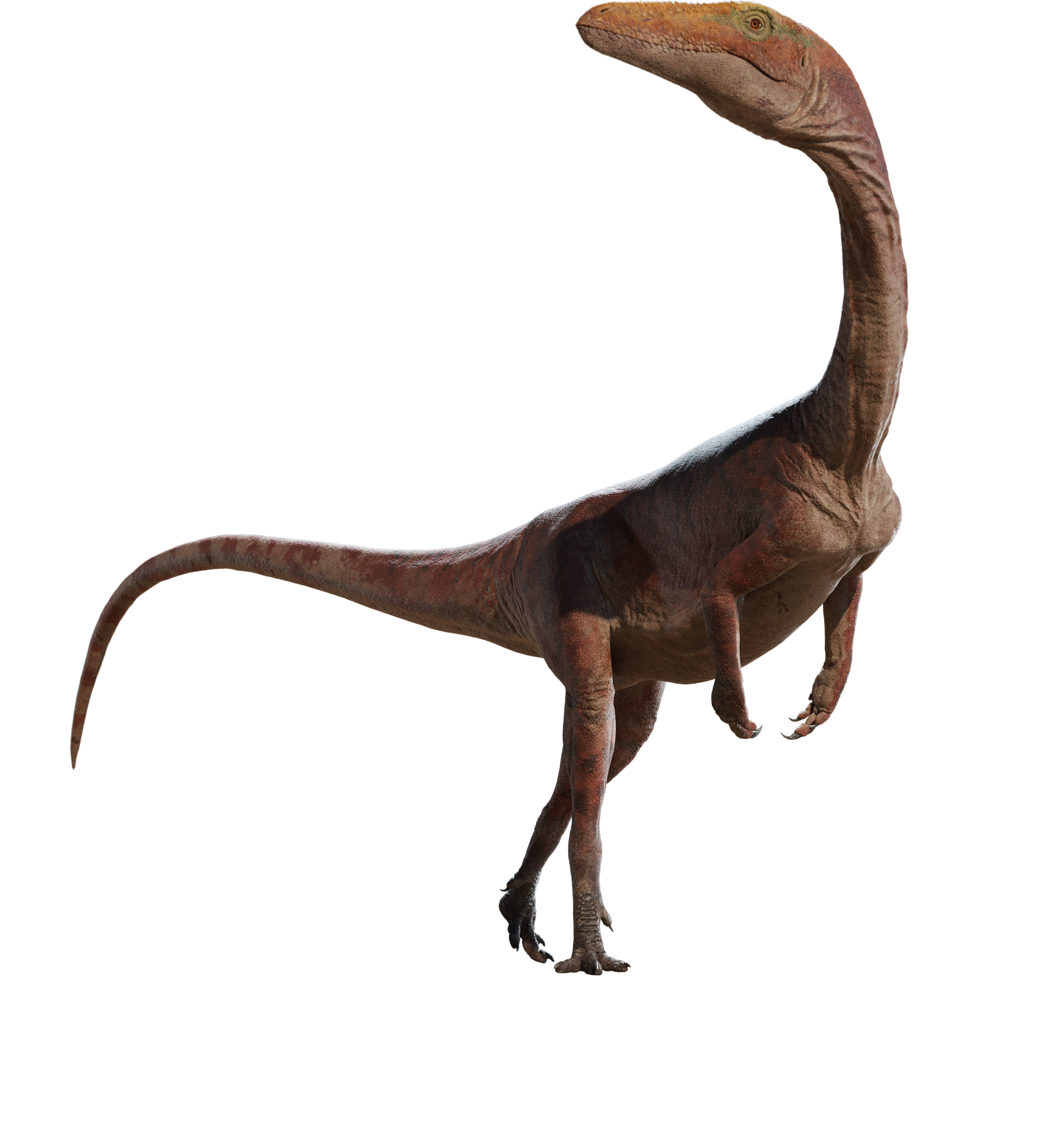The Ghosts of Ghost Ranch
One of the most abundant dinosaurs in the Late Triassic American southwest was the small theropod Coelophysis, one of the best-known dinosaurs thanks to an impressive bonebed at Ghost Ranch, New Mexico, which preserves over 1000 individuals, including complete skeletons!
Overview: In the late Triassic of Arizona and New Mexico, one of the most common dinosaurs was the small bird-like theropod Coelophysis. Since its discovery in 1881, Coelophysis has become one of the best-known dinosaurs thanks to a huge bonebed at Ghost Ranch, New Mexico, discovered in 1947, which preserves over 1000 individuals, including complete skeletons! Coelophysis was one of the earliest undisputed theropods and had already developed a highly birdlike form. It was a generalist opportunist predator, similar to a modern coyote, and was highly adaptable, important in an environment of extremes and in an age of great geologic and evolutionary change.
Discovery: Coelophysis bauri was discovered by David Baldwin in 1881 in the Chinle Formation of New Mexico. In 1889, it was given its name by Edward Drinker Cope, meaning “Hollow Form”, derived from Greek “koilos” (meaning “hollow”) and physis (meaning “form”), so called because of its hollow vertebrae. It was also given the name bauri, in honor of comparative anatomist Georg Baur. The original holotype was fragmentary and gave an incomplete picture of the animal. This changed in 1947 when a mass graveyard of over 1000 Coelophysis was discovered at Ghost Ranch, New Mexico by George Whitaker. Many of these skeletons were complete, and they showed individuals of different ages. The most famous complete skeleton from Ghost Ranch, AMNH FR 7224, was designated the neotype of the species, thus replacing the fragmentary holotype as the defining specimen.
Evolution: Coelophysis was a member of the family Coelophysidae and the slightly more inclusive superfamily Coelophysoidea. Coelophysoids were the earliest undisputed theropods, and the first of the Neotheropoda, a clade which includes all undisputed theropods, leaving out basal theropods like the Herrerasaurids and Eodromeus, which may actually be basal saurischians, not true theropods. Animals like Coelophysis formed the blueprint for every theropod that would follow, from Allosaurus, to T-rex, to birds.
Description: Coelophysis had a basic small theropod body plan, and was by virtue of its phylogenetic position, essentially the prototype theropod. It was bipedal, with a somewhat long head, a long snout, and a long tail. It had long legs compared to other reptiles, and like all dinosaurs, it was digitigrade, meaning it walked on its toes (while we humans are plantigrade, or flat-footed). It was already rather birdlike, and also had hollow bones and an avian-style respiratory system, trait many theropods, including birds, would inherit. It was also the earliest dinosaur to have a furcula or “wishbone”. Like other early theropods, it had four fingers on its hands. Most later theropods would reduce this to three or fewer. It was probably warm blooded and was likely covered in a coat of downy feathers. It had large forward-facing eyes, giving it excellent binocular vision, and its jaws were lined with small, sharp, recurved teeth for slicing flesh. Coelophysis was not a large animal, only reaching 3 meters (9.8 ft) long at the most and weighing 15-25 kg (33-55 lb). It would have stood a little over a meter tall. It had a high level of developmental plasticity, resulting in a high degree of individual variation in size and robustness/gracility.
Behavior and Ecology: The Chinle Formation in which Coelophysis lived dates to about 212-201.6 million years ago. Back then, Arizona and New Mexico was home to lush plant growth, like the giant Araucaroxylon (trees related to modern Araucaria). It was warm year-round, highly seasonal. Part of the year would have been very lush, but the other part of the year would have been hot and dry. Coelophysis was a highly adaptable creature to thrive in these conditions. In fact, its high developmental plasticity was likely an adaptation to help it make the most of whatever resources were available at any given time. Coelophysis was a generalist opportunist predator, mostly hunting small prey, using its own fleet-footedness to catch such items, and using its arms to grab and grasp prey. It probably would not have been above scavenging either, occupying an opportunistic niche similar to coyotes. One known prey animal was the small crocodylomorph Hesperosuchus, an individual of which has been found preserved in a Coelophysis stomach cavity. It was once thought that Coelophysis was a cannibal, however, while it is still possible that cannibalism may have occurred occasionally, the purported evidence for such behavior has been disproven. Coelophysis lived alongside two other dinosaurs, Chindesaurus and Daemonosaurus, which were either basal theropods or basal saurischians, either way more primitive than Coelophysis. Te largest predators in Coelophysis’s environment were Vivaron and possibly Postosuchus (though the latter is unlikely). These large animals were terrestrial relatives of crocodiles, and cousins of the South American Saurosuchus, and may have preyed upon Coelophysis.
Some view the frequent occurrence of Coelophysis and its relatives in multi-individual bonebeds as evidence for pack living. It is clear that they must have had a decent level of gregariousness and at least tolerated each other’s presence. However, they may not have formed permanent groups or hunted cooperatively. The Ghost Ranch Whitaker Quarry probably represents a population of Coelophysis forced together during the dry season or a drought and then washed away and buried by a flash flood. It has been suggested that Coelophysis may have provided parental care to their offspring, perhaps for up to a year. While this is hard to say for certain, it can be reasonably assumed that they provided some degree of parental care, at least to the degree of crocodilians, seeing as both crocodilians (more basal archosaurian relatives of the dinosaurs) and birds (extant dinosaurs) both provide parental care. Coelophysis probably provided at least as much parental care as crocodiles, if not more.
Extinction and Legacy: Coelophysis bauri thrived at the end of the Triassic, but disappeared at the end of the Triassic Period, about 201 million years ago. However, rather than going truly extinct in the End-Triassic Extinction, it is more likely it simply evolved through it. A closely related coelophysoid called “Coelophysis? kayentakatae” which may be a species of Coelophysis, Megapnosaurus, or a new genus, was highly similar to Coelophysis, and appeared in the Early Jurassic shortly after the disappearance of Coelophysis, and may have evolved from Coelophysis bauri. In any case, Coelophysis was replaced by its close relatives, and its kind continued to thrive through the Triassic Extinction and through the Early Jurassic. Coelophysis can now be found at numerous museums, including the New Mexico Museum of Natural History in Albuquerque, New Mexico, USA, the Cleveland Museum of Natural History in Cleveland, Ohio, USA, the Denver Museum of Nature and Science in Denver, Colorado, USA, and the American Museum of Natural History (AMNH) in New York City, New York, USA, where the famous neotype resides. Many museums have replicas of that famous AMNH specimen. Coelophysis has made several on-screen appearances, perhaps most notably in the 1999 BBC documentary Walking with Dinosaurs, and the 2007 National Geographic documentary Dino Death Trap. Coelophysis is the official state fossil of New Mexico (as of 1981).
Coelophysis FAQ
Coelophysis size / How big was Coelophysis?
See height, weight, and length.
Coelophysis height / How tall was Coelophysis?
Coelophysis was around 0.84 meters (2.76 ft) tall.
Coelophysis weight / How much did Coelophysis weigh?
Coelophysis probably weighed about 15-25 kg (33-55 lb).
How long was Coelophysis?
Coelophysis grew up to 3 meters (9.84 ft) in length.
What did Coelophysis eat?
Coelophysis was a generalist carnivore, probably eating anything from small dinosaurs and other reptiles to fish and insects. It also may have scavenged carcasses of larger animals.
What is Coelophysis’s closest living relative?
Like all dinosaurs, the closest relatives of Coelophysis are the only surviving lineage of dinosaurs today, the birds. Crocodilians, while not dinosaurs themselves, are also more distant cousins of dinosaurs.
Coelophysis family members / Coelophysis family / What kind of dinosaur was Coelophysis?
Coelophysis was an early theropod (two-legged, mainly carnivorous dinosaurs) in the family Coelophysidae and the larger clade Coelophysoidea. They are among the earliest definitive theropods known.
Where did Coelophysis live? / Where was Coelophysis found?
Coelophysis lived in southwestern North America and has been found Arizona and New Mexico, with over 1000 specimens coming from Ghost Ranch, NM.
When did Coelophysis live?
Coelophysis lived about 212-201.6 million years ago at the end of the Triassic Period.
What does Coelophysis mean? / Coelophysis name meaning
Coelophysis means “Hollow Form” on account of its hollow vertebrae.

